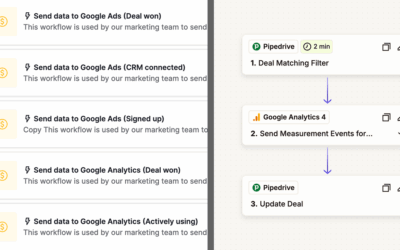As the first CMO at Marketo, I helped build their demand generation engine from the ground up. Back then, we’d mainly use content and other inbound strategies to generate leads.
Then, rather than sending those leads straight through to sales, we would nurture them until they showed signs that they were ready to buy. This created a great customer experience. Sales teams didn’t have to talk to uninterested leads, and customers didn’t get unwanted sales calls.
However, it wasn’t enough. There’s a limit to how much you can scale inbound—you can’t double your pipeline by doubling the number of blog posts you publish. So we started experimenting with other pipeline development strategies, including what is now known as Account-Based Marketing (ABM).
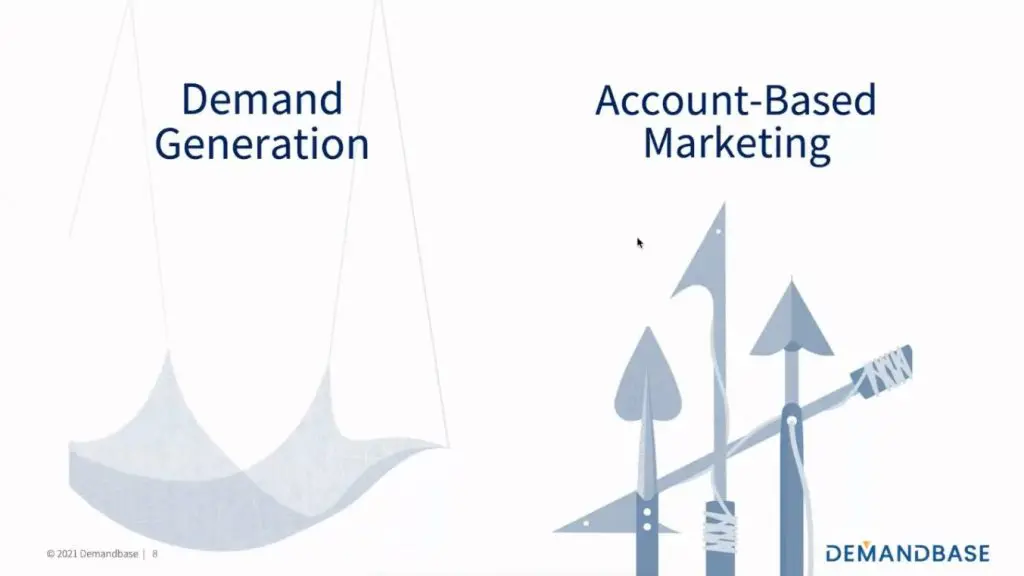
Demand generation is like fishing with a net. You run your campaign without caring which specific person or company gets picked up. On the other hand, ABM strategy is more like fishing with a spear, where you identify the big fish and go after them proactively.
But there’s a problem with this—it doesn’t feel good to get poked by a spear.
The way most companies have been practicing ABM shows that we’ve lost respect for the B2B customer experience, reaching out to companies that had no interest. It wasn’t great, for the sales team or the customer.
Thus was born the concept of Account-Based Experience (ABX). ABX combines the engagement and respect of traditional demand gen with the precision and targeting of ABM. It is a bigger tent that embraces all of the different departments, rather than implying that it’s all down to marketing.
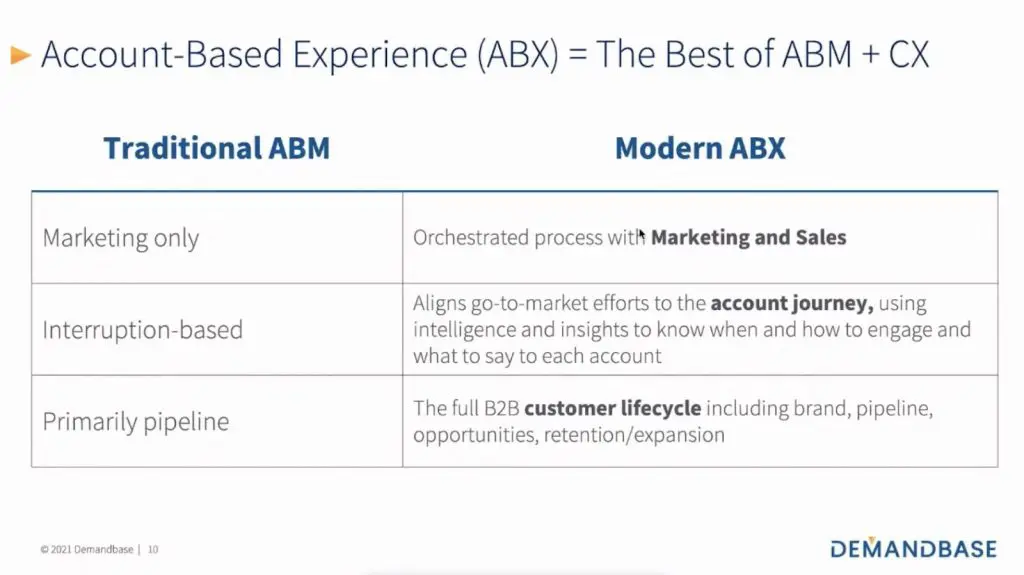
So, how do we carry out ABX? The rest of this article will look at the five key strategies you need in place:
- Building your account data foundation
- Finding the accounts that really matter
- Engaging accounts with relevant and personalized interactions
- Closing those deals by aligning with sales
- Measuring the process
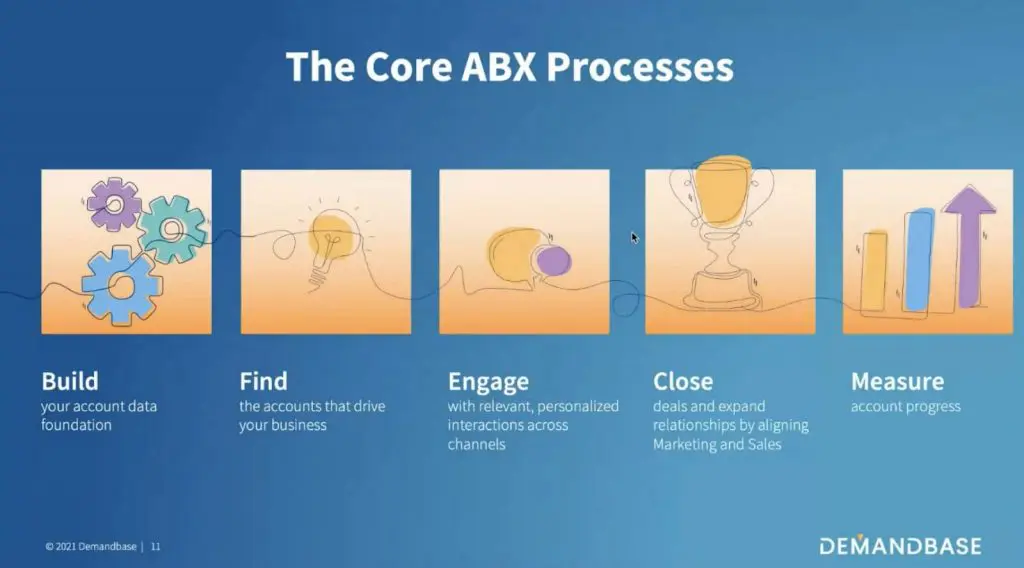
1. Build your account data foundation
Trying to do an account-based strategy at Marketo, I would drive my operations team crazy, all because we didn’t have a single view of accounts. Critical data was scattered across the CRM, emails, and other systems. As a result, marketing and sales didn’t have a shared view of what was going on.
To avoid this problem, the first step is to gather all of your first-party data:
- Your campaigns
- Your leads
- Your contacts
- Your activities
That includes everything in Salesforce, everything in your marketing automation platform, and everything in your emails and calendar events. There’s so much valuable information there, and you need to collect that all together and match it to the right account.
Then augment that with third-party data, including information such as industry, location, company size, parent/child accounts, etc. If you’re a tech company, then use technographics to find out what technologies that company has installed. Intent data is also important, allowing you to see what research accounts are carrying out and whether they’re showing signs that they’re in-market.
You don’t have to do all of this at once, but it is the foundation of everything that follows.
2. Find the accounts that really matter
For most B2B companies, the number of accounts you could be going after is a lot larger than the number you can practically go after, given your resources.
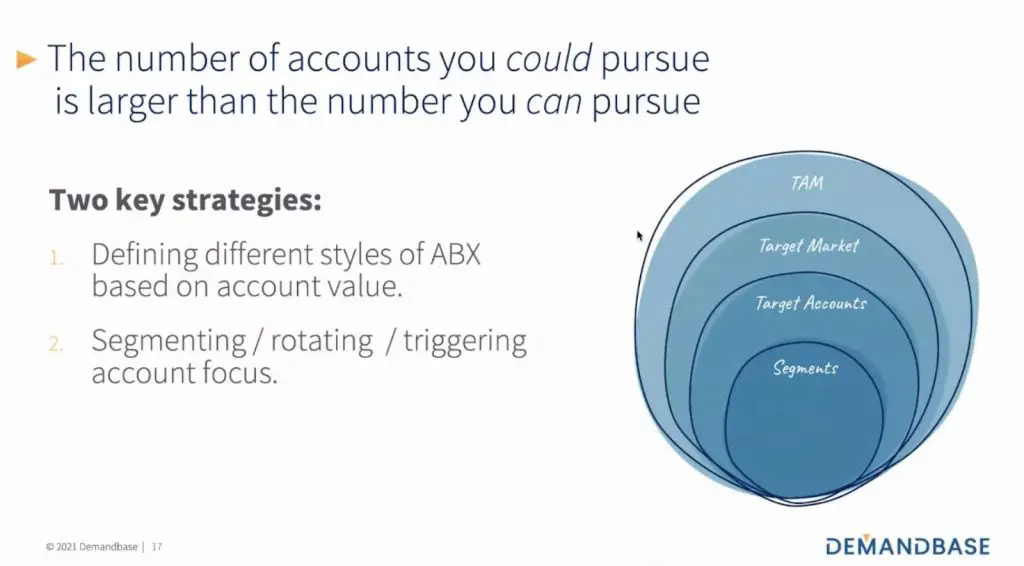
There are two strategies you can use to ensure you’re focused on the best accounts:
- Defining different styles of ABX based on account value
- Segmenting/rotating/triggering account focus
For the first strategy, there are four different tiers of ABX:
- 1:1. Truly bespoke programs that require a lot of investment. Used for a handful of your most valuable accounts, typically those worth $2 million or more.
- 1:Few. A more scalable approach where you focus on micro-segments of 15-20 accounts. Typically for deals worth $250,000 to $2 million.
- 1:Many. Broader programs with less personalization that rely on automation technology. One of the more popular styles, this is appropriate for deals worth $50,000 to $250,000.
- Targeted Demand Gen. Here you market to thousands of accounts without personalization, suitable for deals worth less than $50,000.
It’s important to mention that there’s no one “best” approach. It’s just about using the appropriate strategy for your deal size.
However, one common mistake is for companies to try and use one of the higher levels for too many accounts. As a result, they aren’t able to deliver enough focus and personalization.
To avoid this, my recommendation is to first define your entitlements—the way you’re going to treat and interact with each account—before you tier your accounts. Those entitlements fall into four major buckets:
- Data – How are you going to make sure you have the right data for each account?
- Advertising – How much will you spend on advertising to each account?
- Direct Mail – More valuable accounts can get more expensive, custom direct mail
- High Value Offers – Highly bespoke but not easily scalable offers, such as a one-to-one meeting with your CEO
Once you define your entitlements, you know exactly how many accounts you can afford to have in each style. To identify which accounts go into which style, we use the FIRE methodology:
- Fit – How close is the account to your Ideal Customer Profile (ICP)?
- Intent – How much interest are they showing in your products and/or competitors?
- Relationship – What is the context and history within the account?
- Engagement – How much time have they spent with your company?
At Demandbase, we then combine all these into a fifth score that we call Pipeline Predict, which is really about whether or not an account shows the pattern of behaviors that other accounts have shown as they were leading up to becoming an opportunity. If so, that tells us that this account is likely to be hot (what we call a Marketing Qualified Account, or MQA) and deserving of that extra focus.
This can then be used with the second strategy, where the focus is based on specific segments. Besides hot MQAs, you might decide to spend this quarter focusing on accounts that use a specific competitor’s solution, or who are in a particular industry. You could also use triggers, such as accounts hiring a new executive or showing intent signals.
3. Engage accounts with relevant and personalized interactions
The key to interacting with accounts is being relevant. Research has shown that executives will respond to unsolicited marketing materials, as long as they contain ideas that might be relevant to their business. Otherwise, with the amount of noise that’s out there, you’ll be ignored.

Therefore, you need insights, which comes back to that foundational knowledge. Where is the account in their buyer journey? Are they showing intent? What technologies are they using? Who are their competitors? None of this has to be hard; you can automate a lot of these insights. But, collectively, they drive relevance.
Next, you need to think about what channel you’re going to use to interact with these people. There are ‘human’ interactions—such as SDR outbound, events, and executive-to-executive outreach—which are critical in any ABX strategy. And then you have methods that aren’t super scalable but can be highly customized, like direct mail. Lastly, these can be complemented by more scalable channels, like digital advertising and website personalization.
Let’s take a closer look at account-based advertising. This is one of the channels that B2B marketers are most satisfied with, but it comes with challenges.
Engage accounts with account-based advertising
First of all, you need to optimize across accounts, which is harder than it sounds. With typical advertising solutions, the number of impressions each account gets is usually proportional to the number of people at that account. In practice, this means the vast majority of your advertising budget goes to just the top 10% of accounts.
For example, if you’re going after retailers, then Walmart is going to get a couple of hundred times more impressions than a company like Lands’ End. As a result, it’s preferable to use a DSP that allows you to allocate your budget evenly across accounts.

The second challenge of account-based advertising is ensuring that you get your ads in front of the right people at the account. That’s often done by title targeting. The problem with that is the B2B data around those titles sucks. Even with good data, there’ll be a lot of people with that title who aren’t relevant. Instead, it’s better to use intent-based targeting, which allows you to focus your bids on the specific people who are showing intent for your solution and are much more likely to be a part of the buying committee.
Orchestrate engagements across channels for maximum effectiveness
When it comes to engagement though, it’s not about any single channel—it’s making all the channels work together for maximum effectiveness, working in harmony to create a good customer experience. The best way I’ve found to think about orchestration is by aligning your interactions to the account journey.

At the beginning of their journey, your priority is to build a foundation of trust. As they progress to the Awareness and Engaged stages, your message should switch from emotional to more logical, using thought leadership and education.
Once they’re a Marketing-Qualified Account (MQA) and you know they’re interested in hearing from you, it’s time to reach out. For identified opportunities, focus on validation and talking to the entire B2B buyer committee.
Finally, enhance the post-sale customer experience with adoption best practices and investigating potential expansion opportunities, always with interactions that are based on relevant insights.
4. Close those deals by aligning with sales
For an account-based strategy to succeed, it’s critical that marketing and sales work together to close the deal. In classic demand generation, this was a baton handoff—marketing generates a lead, scores it, then and passes it to sales.
In this new world, it looks more like a soccer team, with people passing the ball back and forth all the way up the pitch. This sounds great, but it’s easier said than done.
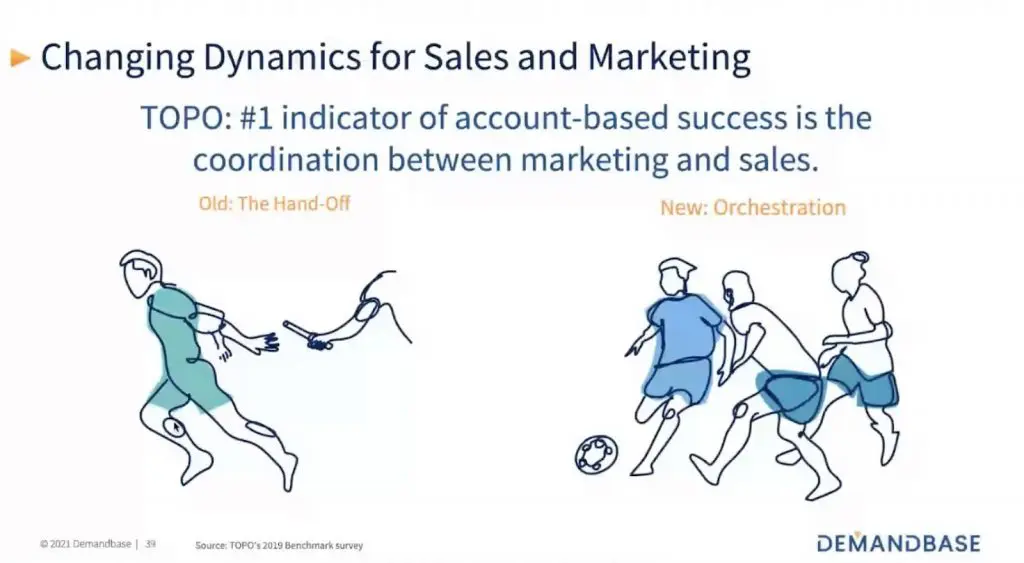
There are three levels of alignment:
- Alignment of data, so that you’re both on the same page
- Sharing insights, enabling the sales team to do their jobs better
- Coordinating interactions, working together for better results
Aligning the data goes back to that initial account foundation. Proactively sharing insights might mean alerting the sales team whenever a target account does something meaningful, like showing intent for a competitor or downloading a key analyst report.
When it comes to that third level though, where you’re truly working as a team, the most important thing you can do is start holding ABX stand-ups. This is a meeting, held just between the marketer, salesperson, and the SDR (if you have one), that takes place every two weeks for 15 minutes.
The only item on the agenda is to talk about the sales rep’s accounts. What are they doing that might be relevant and interesting? What are you going to do collectively to engage with that account and progress them along their journey?
It isn’t rocket science, but I don’t know of a single better strategy to drive sales and marketing teams alignment.
Run ABM workflows across all tools
Sync data, score leads, and trigger the best next step with each lead.
Seamless integrations with Pipedrive, HubSpot, Salesforce, and Copper.
5. Measuring your account-based program
The key here is to understand that it’s about quality, not quantity. Are you engaging with the right people at the right accounts?
Sometimes, that can be as simple as tracking web visits. Set a baseline for how much web traffic you’re getting from your target accounts, and then see how ABX affects that. If you’re seeing a lift in account activity, then that’s a good indication that this program is working. You can then dig deeper and see exactly where the engagement is coming from. What channels, personas, segments, territories, and so on are generating the most engagement?
The other way to measure success goes back to the account journey. For each stage of the journey, look at the four V metrics:
- Value – How many accounts do you have in each stage?
- Volume – How many accounts are moving from one stage to the next in a given month/quarter?
- ConVersion – What’s the conversion rate from stage to stage?
- Velocity – How fast are those accounts moving through the journey?
These are the metrics we look at every week, every month, every board meeting, to understand how our account-based strategies are working.
Final thoughts
When it comes to ABX, you should think big, but you should also start small and move quickly. It doesn’t have to be overwhelming, or a major transformational effort. There are baby steps you can take to get started.
Pick out accounts that match your ICP. Do some basic prioritization based on intent. Pilot account-based advertising. Make sure you have some sort of account data infrastructure in place.
By starting with these steps, and then building on your ABX program with the strategies we’ve discussed, you can focus your efforts on the accounts that matter most. Then, both you and your accounts can enjoy the benefits of an improved account-based experience.
Learn about these strategies and more in The Clear & Complete Guide To Account-Based Experience (ABX), with over 250 pages of practical advice and best practices.
Watch Jon’s “The Complete Guide to Account-Based Experience (ABX)” session from Revenue Marketing Bootcamp 2021 to hear this post and more out loud, presented by Jon Miller himself:



